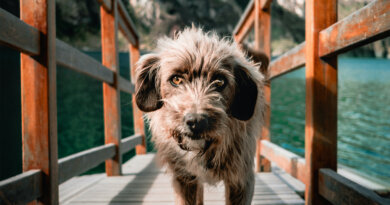How to Build Confidence in a Fearful Dog
The most critical thing you can do for your fearful dog is to have respect for that fear. When our dogs are scared of something that seems absurd to us – a guy in a hat, the vacuum, a flag blowing in the wind – we humans tend to respond by either laughing it off or getting frustrated, saying, “Oh, come on, that’s not going to hurt you.” We carry on normally (brushing right by the man in the hat) thinking one of these days the “silly” dog will figure out nothing bad is going to happen.
The thing is, from your dog’s perspective, the bad thing did happen. She was terrified, and her “trusted” human put her through that heart-pounding feeling again. So now she’s scared of The Thing and she feels nobody’s got her back. That’s not the road to confidence-building. In fact, it’s the opposite. Here are five tips for growing and nurturing your fearful dog’s ability to move through the world with courage and poise.
Step 1: Eliminate the Scary Triggers

Nobody can learn when they’re scared and dogs are no different. That’s why we have to start this process where – from your dog’s point of view – there is nothing to be afraid of. That means making sure there are no events that leave your dog trembling, hiding, pulling away, barking, growling, or drooling in fear.
The more precise you can be in identifying what scares your dog, the better. For example, is she worried about:
- All men, or just the ones in hats?
- All other dogs, or only the ones who bark?
- Guests at all times, or only when they stand up and walk around?
Once you have those answers, you have a job: In this initial phase, keep any encounter with those things from happening. That might be easy; maybe you just have to tell your guests to take off their hats before coming inside. Or it might be incredibly difficult; maybe you have to quit your regular city walks entirely for now to avoid other dogs, and rely on indoor mental stimulation instead.
Either way, take heart: This stage doesn’t last forever. You will eventually move into re-introducing these triggers at an intensity your dog can handle, ideally turning them into a “Ho-hum, nothing to see here” part of life.
Step 2: Make Everyday Life Predictable
Many dogs who have a few big obvious triggers also have a general level of skittishness even when nothing much (from the human’s point of view) is happening. Some dogs live in a perpetual state of vague concern, which makes them more likely to fly off the handle when they do encounter one of their triggers. You can reduce this chronic concern by building more overall predictability into your dog’s life. Anxiousness is rooted in not knowing what’s going to happen next. To keep the overall, 24/7 arousal level as low as possible, create as much routine as you can. Do the same things, the same way, at the same time, every day.
Note that talking to your dog in a purposeful way can play a dramatic role in building predictability and increasing confidence. Narrate life so your dog can more quickly put various things in a “not to worry about” category. “Oh, yes, I do see that neighbor! It’s okay, that’s just our neighbor.” A piece of cheese after that conversation never hurts. (See “How to Talk to Your Dog,” June 2022.)
Step 3: Build Your Dog’s Trust in You

When we get to the stage of re-introducing triggers, you’re going to be your dog’s guide, helping him feel it’s okay to explore just a bit more closely. For this, your dog needs to trust you, absolutely. Before you think “Oh, he loves me, we’re already there,” just take this little quiz:
- Do you ever “make” your dog do stuff because you’re in a hurry? (Like drag him away by his leash from something he won’t leave alone, or just pick him up and carry him when he’s hesitant to come with you?)
- Do you ever yell at (or even around) your dog when you’ve had a bad day?
- Do you ever keep hugging your dog when he’s turning his head and pulling away?
These kinds of things may seem small to you, but day after day, interaction after interaction, they block the establishment of full trust. If you want to help your dog gain confidence, he must feel utterly secure with you. To get there, slow down. Respect your dog’s body language, and give him more say in his own life.
Step 4: Do Simple Training at Home
It may seem counter-intuitive that as I’m telling you to give your dog more agency, I’m also about to tell you to do more training. But that’s because the good kind of training isn’t about top-down commands and blind obedience (talk about a confidence-buster!) but is instead about teaching your dog that good things are in her grasp, and the key is choosing to follow your direction: “Phew! I know exactly what’s going to happen in this situation! When my person says touch, all I have to do is put my nose to her hand and I get a treat.”




